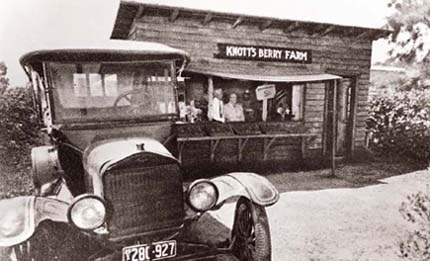|
THE
HISTORY

Walter & Cordelia Knott
at original berry stand, with Model T Ford, 1928
photo courtesy of oc.book.com
Buena
Park today is best known as the home of several
world-famous tourist attractions, but the town
originally was put on the map in the late 1800s
by a Chicago businessman and the Santa Fe Railway.
In
1887, James A. Whitaker, a wholesale grocer from
Chicago, bought 690 acres of the Stearns Rancho,
part of what was once the sprawling Rancho Los
Coyotes. Whitaker intended to create a cattle
ranch, but Santa Fe Railway officials convinced
him to use the land for a new town, according
to "The Picture Story of Buena Park," compiled
by H.A. "Hub" Chamberlain.
Whitaker
filed his township papers in Los Angeles County
(Orange County had not yet been formed) to create
the town of Buena Park. The city was not incorporated
until 1953.
Buena
Park first became known as a dairy center, and
both the Santa Fe and Southern Pacific railroads
built there. The Lily Creamery started operations
in Buena Park in 1889. With the exception of a
few wineries, the creamery was the first industry
in the city, according to Chamberlain's 1971 book.
Today,
the city's main claim to fame is as the home of
Knott's Berry Farm, Medieval Times (where knights
joust before crowds of diners) and Movieland Wax
Museum. The city has grown from about 1,000 people
in 1900 to more than 77,000 people today and covers
about 10 square miles.
Buena
Park's five-member City Council recently has embarked
on ambitious redevelopment plans to help revitalize
its economic base with more retail and commercial
businesses while also updating the city's entertainment
and tourist corridor along Beach Boulevard.
City
officials attribute much of the Buena Park's physical
and financial growth to the Knott family. Tourism
generated by the Knott' amusement park is the
single largest source of revenue for the city.
Walter Knott and his family arrived in Buena Park
in 1920 and began farming on 10 acres of rented
land. Eight years later, the family built a permanent
roadside stand where berries and plants were sold.
In 1934, Cordelia Knott, using her own wedding
china, served customers her first chicken dinners
at 65 cents each. In 1940, Walter Knott began
assembling his Ghost Town attraction as a diversion
for hungry patrons waiting for their chicken dinners.
Historical
Sites:
Knott's
Berry Farm and Old Maizeland School - 8039
Beach Blvd
Walter Knott founded the present-day amusement
park in 1920 as a 10-acre berry farm. He later
added a tea room and a berry market. Old Maizeland
School was built in 1868 in the county of Maizeland
(later the city of Rivera, now Pico /Rivera in
Los Angeles County. The one-room school was donated
to Knott's in 1959. Both Knott's Berry Farm and
the school are marked with plaques.
Whitaker--Jaynes
Estate Park
Two
historic homes: The Bacon House and the Whitaker--Jaynes
House. Andrew
West Whitaker built his house in 1887 upon his
arrival from Indiana. His brother James bought
690 acres of land to establish a cattle ranch,
but ended up subdividing the property and creating
the city of Buena Park. The house was sold to
Issac Jaynes in 1903, and his family resided in
it till 1965. The city created this park out of
the house grounds, and it is maintained by the
Buena Park Hitorical Society. The Whitaker--Jaynes
house is furnished with authentic furnishings
from that time period, including a bedroom set
that belonged to Cordelia Knott. The Bacon House,
built in 1884 in the single wall style of construction.
It was moved from the original site and restored
at the Estate Park to Celebrate the Bicentennial.
Original Bacon Family heirlooms may be seen inside
the house.
The
Whitaker-Jaynes and Bacon Houses are open to the
Public by the Buena Park Historical Society, FREE
of charge. Call for appointment or for current
hours.
7842
Whitaker Ave
Buena Park, CA
(714)
562-3570
|


![]()


